ghazi52
PDF THINK TANK: ANALYST

- Joined
- Mar 21, 2007
- Messages
- 104,413
- Reaction score
- 106
- Country
- Location
New evidence challenges the Pentagon’s account of a horrific attack as the US withdrew from Afghanistan
By Nick Paton Walsh and Mick Krever, CNN.
Video by Mark Baron and Christian Streib, CNN.
Wed April 24, 2024
CNN —
New video evidence uncovered by CNN significantly undermines two Pentagon investigations, the latest of which was released last week, into an ISIS-K suicide attack outside Kabul airport, during the American troop withdrawal from Afghanistan in August 2021.
The incident was a gruesome coda to America’s longest war, leaving dead 13 United States military service members and about 170 Afghans who were desperately seeking US help to flee the Taliban takeover of Kabul. For two years, the US military has insisted that the loss of life was caused by a single explosion, and that troops who reported coming under fire and returning it were likely confused in the chaotic aftermath, some suffering from the effects of blast concussion.
But video captured by a Marine’s GoPro camera that has not been seen publicly in full before shows there was far more gunfire than the Pentagon has ever admitted. A dozen US military personnel, who were on the scene and spoke to CNN anonymously for fear of reprisals, have described the gunfire in detail. One told CNN he heard the first large burst of shooting come from where US Marines were standing, near the blast site. “It wasn’t onesies and twosies,” the Marine said. “It was a mass volume of gunfire.”
An Afghan doctor who spoke to CNN on the record for the first time said he personally pulled bullets from the wounded, and with his hospital staff counted dozens of Afghans who died from gunshot wounds.
Combined, the new evidence challenges the credibility of the two US military investigations and raises serious questions for the Pentagon, which has continued to dismiss mounting evidence that civilians were shot dead.
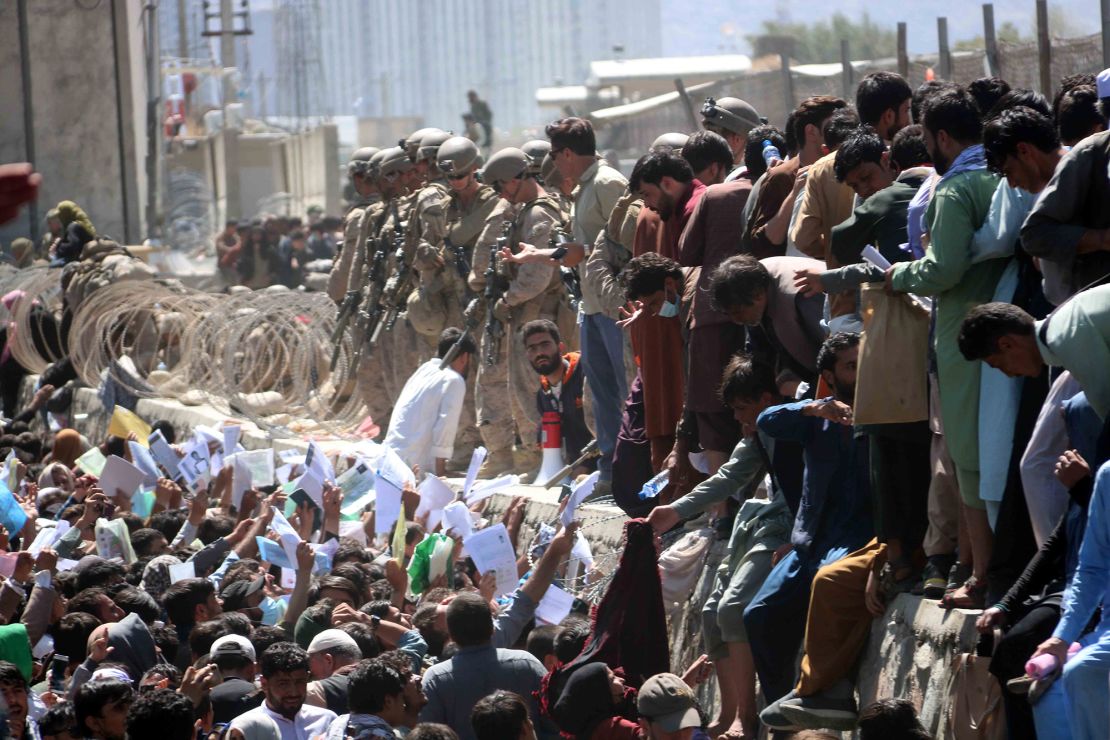
Afghans struggle to reach foreign forces in desperate attempts to flee the country before the blast outside Hamid Karzai International Airport, in Kabul, on August 26, 2021. Akhter Gulfam
The blast at 5:36 p.m. on August 26, 2021, outside Hamid Karzai International Airport marked the worst casualty incident for Afghan civilians and US troops in Afghanistan in over a decade.
For days, hundreds of desperate Afghans – military aged-men, women, children, and the elderly – had been standing in the blistering heat, hoping to persuade their way into the airport and onto a stream of US cargo planes that flew over a hundred thousand people out to safety.
The scene outside the airport’s Abbey Gate, where crowds were densest, was gruesome even before the blast. Former translators and other Afghans who had assisted the near-20-year NATO presence waded in trash and knee-deep sewage water that filled a concrete drainage canal.
When an ISIS-K suicide bomber detonated a backpack device just above the densely populated concrete canal, the evacuation was drastically curtailed.
The Pentagon has insisted all deaths and injuries were caused by the explosive device and the ball bearings it fired into the crowd. Though it has acknowledged there was gunfire from American and British forces, it says that was limited to three bursts that were near-simultaneous – one of 25 to 30 warning shots from UK troops, and two bursts of fire from US troops aimed at suspected militants, which did not hit anyone.
The US Central Command ordered a supplemental review into the incident in September 2023, after criticism of its investigation’s conclusions, particularly around whether the bombing could have been prevented – in harrowing emotional testimony from survivors on social media and to Congressional hearings.
Those results, which were released on April 15, reaffirmed that a lone ISIS-K bomber carried out the attack, and found that “new information obtained during the review did not materially impact the findings in the November 2021” investigation, and the review “did not recommend any modifications to those findings.” The review did not pursue numerous reports from Afghan survivors of significant gunfire in the wake of the blast.
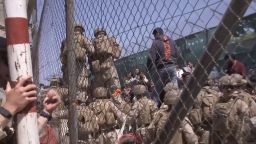
The Marine’s GoPro footage runs nearly continuously for many minutes before and after the blast. It shows 11 episodes of shooting after the explosion, over nearly four minutes. This is significantly more than the three “near simultaneous” bursts of gunfire that the Pentagon investigations have claimed occurred.
One sustained burst of about 17 gunshots comes just over 30 seconds after the bomb detonates, according to the video, with the other 10 bursts of two to three rounds each. At no point are Marines seen firing on camera or is anyone visibly hit by gunfire. It is unclear where the gunmen are or what they are firing at.
It shows Marines, some on their first deployment to a warzone, race for cover from gunfire, and choke from CS gas released when the blast tore open a canister on a Marine’s flak jacket.
One Marine, presumably the cameraman, notes after the blast: “I got that on film, dude.” Seconds later, as Afghans seem to race towards the airport walls to seek safety, another voice adds: “They’re breaking through.” The remainder of the footage shows the Marines swiftly getting accountability of their own units, struggling to come to terms with the blast’s impact, and hearing a steady series of controlled, isolated bursts of gunfire close by.
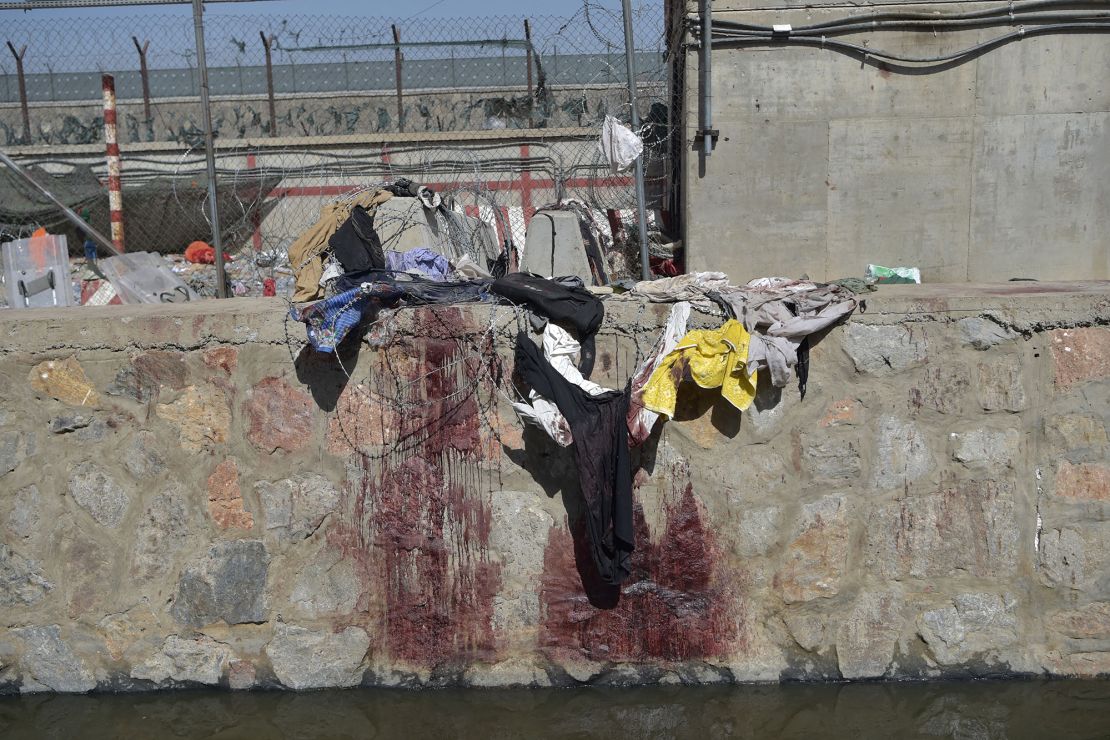
Clothes and blood stains at the scene on August 27, 2021.
Wakil Koshar/AFP/Getty Images
Robert Maher, an audio forensic expert at Montana State University in Bozeman, who reviewed the footage for CNN, found at least 11 episodes of gunfire over a four-minute window, totaling a minimum of 43 shots. He added that the burst near the start contained at least 17 shots, with multiple weapons likely firing and overlapping. He said in two other bursts of fire, the rounds appeared to follow a “crack-boom” sequence – the crack of the bullet breaching the sound barrier recorded before the sound of the gunshot reached the microphone – indicating the bullet traveled over or across the camera.
Sarah Morris, a digital forensics expert from the University of Southampton in England, examined both the audio and video files for evidence of digital corruption, alteration, or manipulation, and found none. She said the location data and metadata of the two clips that lead up to and follow the blast showed they were filmed “very close to each other.”
Separately, Morris used an algorithm to phase out predictable background noise on a GoPro from clothing or motion, and found in 16 instances where there were peaks in audio which she said were “unusual noises that appear consistent with a firearm.” The 16 overlapped with the 11 episodes discerned by Maher.
While some Marines aid wounded Afghans, the video also shows that, 21 minutes and 49 seconds after the bombing, Marines fired a CS gas canister from inside the airport walls towards the area near the blast. It may have landed near injured and dead Afghan civilians, still gathered around the sewage trench that ran along the scene of the blast at that time, according to videos shared on social media.
The Pentagon’s investigations have made no reference to the video, half an hour of which CNN obtained. It is unclear how much of it the Pentagon saw prior to publication of this story. It released four seconds of the video – the moment of the blast itself – as part of its initial investigation in February 2022, although the source of that brief clip remains unclear.
CNN described the full video and findings of this story in significant detail to the Pentagon ahead of publication. A spokesman said the Pentagon would need to see any “new, previously unseen, video out there” before assessing it. Army Lt. Col. Rob Lodewick, public affairs adviser to the supplemental review team, said the latest review supported the Pentagon’s initial findings.
He said in a statement: “The 2021-2022 Abbey Gate Investigation thoroughly investigated the allegations of a complex attack”, which would have involved gunfire from militants after the blast, “as well as allegations of outgoing fire from US and coalition forces following the blast. The Supplemental Review found no new evidence of a complex attack, and uncovered no new assertions of outgoing fire post-blast. Consequently, the Supplemental Review found no materialistic impact to the original findings of the Abbey Gate investigation.”
A spokesperson for the British Ministry of Defense said that its troops fired “warning shots above the crowd to prevent a surge,” none of which were fired at people – the same position it held in 2022.
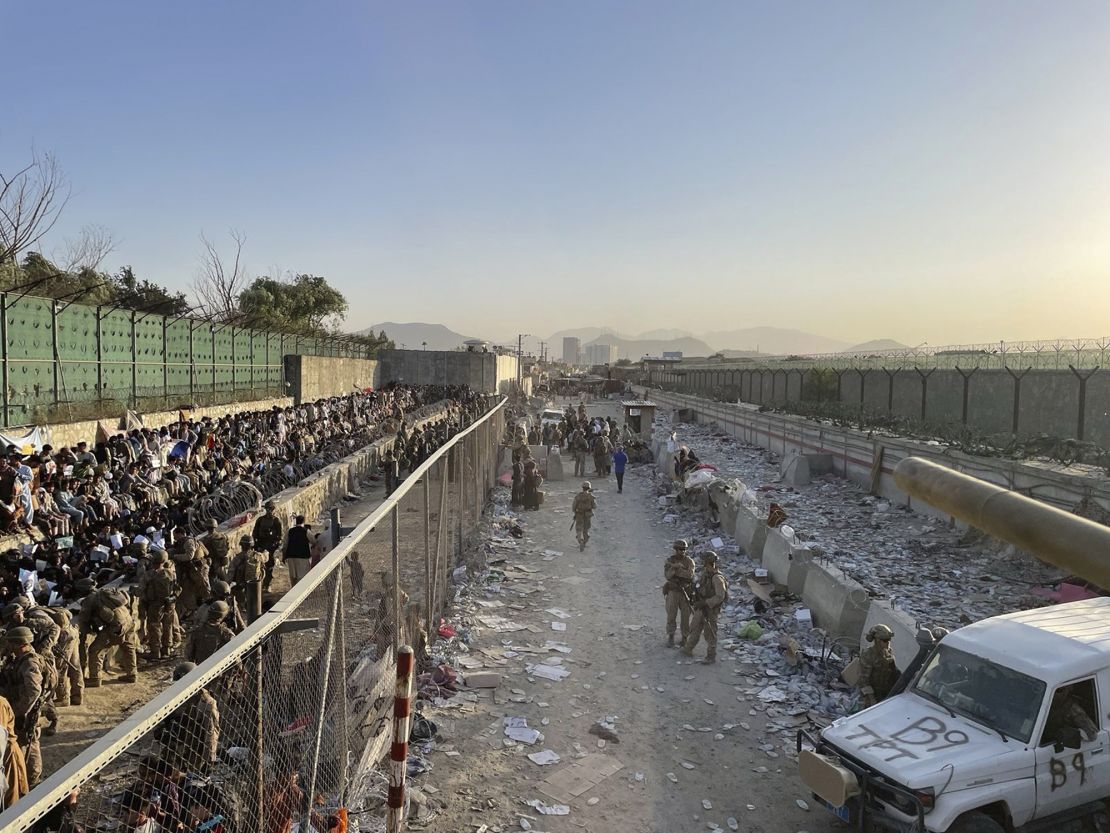
The bombing area at Kabul airport's Abbey Gate on August 26, 2021, prior to the explosion.
U.S. Central Command/AP
CNN has previously reported that 19 Afghan witnesses said they saw gunfire or were shot themselves.
“I saw people who were injured in the explosion trying to get up, but they fired on them,” Shogofa Hamidi, whose sister Morsal was shot in the face, told CNN for an in-depth report published in February 2022. “They were targeting people,” another, Nazir, 16, told CNN. “In front of me, people were getting shot at and falling down.”
Noorullah Zakhel, whose cousin was killed, said that bullets appeared to hit those who tried to flee, and recalled soldiers standing in front of him, as he dropped to the ground below the canal wall. Their accounts were supported by that of a doctor and 13 medical reports which detailed bullet wounds among Afghans.
In 2022, Dr. Sayeed Ahmadi, director of the Wazir Akhbar Khan hospital in Kabul, spoke to CNN anonymously as he feared for his safety. He now has asylum in Finland, where he agreed to speak on camera about the harrowing scenes that night in his trauma unit.
“Explosion injuries come with severe injuries and lots of holes in the bodies,” he explained. “But people who were shot had just one or two holes in the chest or head.”
Ahmadi spent many years treating injuries across war-torn Afghanistan. “Of course, when you see the bullets, it’s totally different from the ball bearing. Everybody knows if they are a soldier or a doctor.”
Video obtained by CNN shows bodies piling up outside the hospital on the night of the attack. As they treated patients, Ahmadi said he received a threatening phone call telling him to stop his team from recording which patients had been shot and who had been killed or injured by the blast.
Afghan doctor: ‘More than half were killed by gunshot’
“He spoke fluently Dari,” he said. “He told me, ‘What are you doing, Doctor? You love your life. You love your family. This is not good when you are collecting that data. It would make a big dangerous situation for you. You should stop that as soon as possible.’”
The man called another time to repeat the warning, and Ahmadi advised his team to stop recording data and destroy the evidence they had collected.
The Pentagon, in response to Ahmadi’s initial anonymous statement to CNN in 2022 that he had treated gunshot wounds, said that he was mistaken. They said bullet and ball-bearing injuries are hard to distinguish – a claim disputed by multiple combat medics who spoke to CNN, and by Ahmadi himself.
Ahmadi said he was never approached by American investigators.
“I hope one day they ask me,” he said. “Now I am safe. I feel well… Sometimes just this secret that I have in my mind haunts me.”
Pentagon spokesman Lodewick said no Afghans were interviewed for the original AR 15-6 investigation “because its scope and focus on US operations did not demand it.” He said the supplemental review was “even more refined” in its scope, focusing more on events before the blast and the bomber, “and again presented no overwhelming need for the pursuit of external Afghan-centric information.”
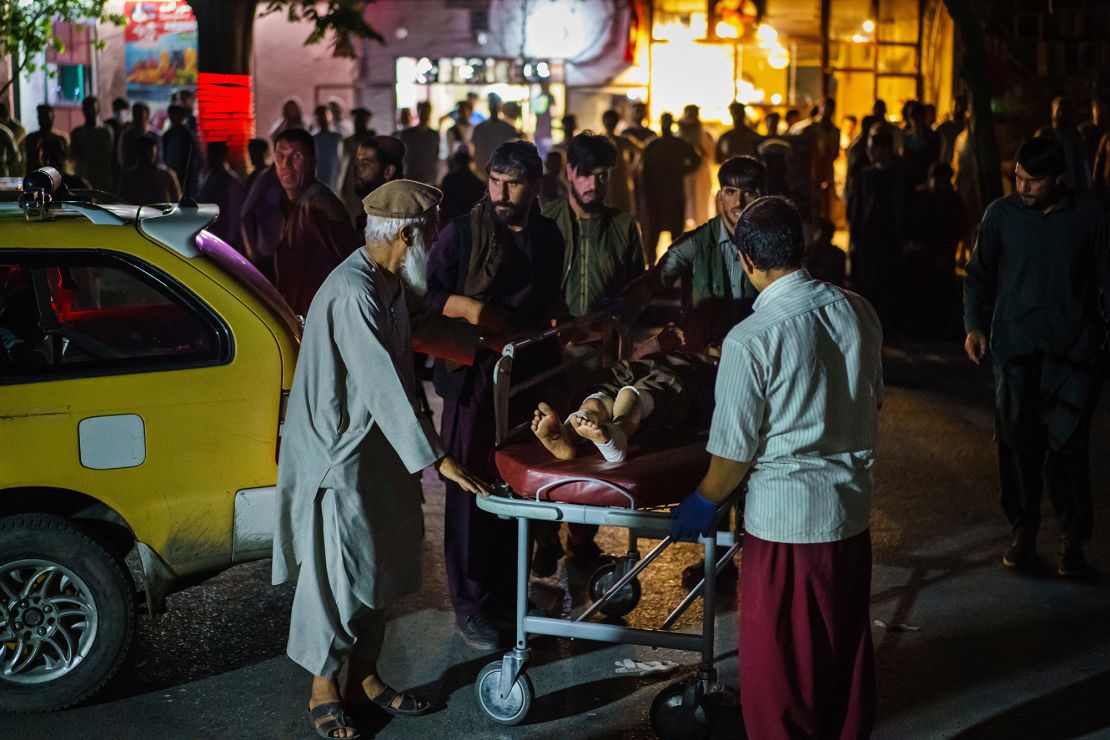
A wounded patient is brought by taxi to the hospital in Kabul on the day of the attack.
Marcus Yam/Los Angeles Times/Getty Images
Accounts from US servicemen of the aftermath have often been dismissed by officials as the product of blast concussion, or Traumatic Brain Injury (TBI). As Marine survivors leave active duty and continue to struggle with their trauma and an official narrative that jars with their personal experience, their dissent has grown.
CNN spoke with about ten Marines anonymously, many of whom described hearing gunfire and feeling under attack from it. Some have reported seeing what they thought was a militant gunman. The Pentagon has insisted no other gunmen opened fire in the area at the time of the attack, bar US and UK troops. No American or Afghan witness has specifically stated they directly saw a militant open fire.
One Marine, who decided to speak out of conscience and requested anonymity, fearing reprisals for his account, has become the first American eyewitness to describe shots fired from where US personnel were located. He said that the burst of gunfire after the explosion – heard by witnesses on the ground and audible in the new video – came from the area around the Abbey Gate sniper tower, where US Marines were grouped.
While he could not be certain the Marines had fired directly into the crowd of Afghan civilians in front of them, he said: “They would not have fired into the air.” Marines had been told to not fire warnings shots, he said, as these rounds fired in the air often landed later in civilian areas. “It wasn’t a direct order,” he added. “But it was a common understanding: no warning shots.” He said he did not think any of the shots fired in the four-minute window of gunfire audible on the new video would have been warning shots.
A Marine eyewitness told CNN's Nick Paton Walsh (left) that the burst of gunfire after the explosion – heard by witnesses on the ground and audible in the new video – came from the area around the Abbey Gate sniper tower, where US Marines were grouped. CNN
Public orders issued in the Navy in December 2020 banned warning shots unless specifically permitted on deployment. The Pentagon’s report said Marines from the 2/1 unit that made up most of those on the scene “did not use warning shots and only used flash bang grenades infrequently.” The Marine said he did not see any US military open fire and did not fire himself.
The Marine calmly described key details of blast and its aftermath, but became emotional when discussing the Pentagon’s investigations, including what he described as a lack of transparency about what happened, and the possible role Marine gunfire played in raising the Afghan civilian death toll.
But he defended the immediate response of his colleagues under attack. “The reaction that the Marines had was a reaction that I believe anybody trained to do in that scenario would have had,” he said, suggesting they were in the first phase of the three-stage practice of RTR – Returning fire, Taking cover and then Returning accurate fire.
“You’ve got to think, these are kids,” he said. “They’re young. And they’ve only been taught what they’ve been taught. Some of these kids had been with the unit for quite literally two, three months prior to deployment. They didn’t have the training to be able to recognize some of the things that, you know, might have occurred – nor could you have the training for what had happened on August 26. Or really what happened in Kabul.”
He said the significant gunfire response from Marines after the blast was common knowledge among Marine survivors, even though it was not spoken of publicly. “It’s incredibly weird,” he said. “It’s frustrating, you know? Why hide from what happened?”
Reacting to the Pentagon’s dismissal of accounts from US personnel who recalled gunfire as the product of TBI, the Marine said: “It’s a pathetic excuse. To say that every Marine, every soldier, every Navy corpsman on the deck has a traumatic brain injury and cannot remember gunfire is, is lunacy. It’s outright disrespectful. And especially for it to come from somebody that wasn’t there.”
“To the Afghani [sic] families – I’m sorry that after 20 years of war, that that is the way that this (was) conducted. And that we weren’t able to uphold a promise that we gave your people after removing the Taliban in 2001. And it should not have ended like that.”
Evacuees aboard a US Air Force C-17 Globemaster III aircraft during the Afghanistan evacuation from Kabul on August 21, 2021.
Senior Airman Taylor Crul/U.S. Air Force/Reuters
Many of the 10 other Marines with whom CNN spoke anonymously also describe gunfire.
One told CNN that he ran through a hole in the fence outside the Abbey Gate in the minute after the blast to assist with the wounded. As he emerged, he said, he heard suppressed rifle fire nearby from another Marine. Many US Marines’ rifles were fitted with suppressors, reducing the noise of their fire, according to footage from the incident.
“I would probably say five, 10 meters away from me, was where it was,” he said. He said the Marine firing was not from his own unit, and after he had opened fire, “whoever was shooting at us wasn’t shooting at us anymore.”
Another Marine told CNN he was about 20 meters (65 feet) from the blast. “There was definitely, shooting,” he said. “Snapping over our heads after the blast and it wasn’t the Taliban.” He said he used his rifle optic to look at the Taliban, who were some distance away on nearby shipping containers used to control access to the Abbey Gate area. “When I looked over at them, none of them were holding their guns. They looked just as shocked as us.”
Other US servicemen who said they witnessed gunfire in the aftermath of the bombing have spoken out on social media.
Sgt. Romel Finley, who received a Purple Heart, said that another sergeant ordered US troops into position to open fire after the bomb blast. Finley told The Brrks YouTube channel, a social media account run by a former Marine and Master Barber which interviews active or former Marines, that he recalled, while being dragged from the scene, “My platoon sergeant running past us, saying ‘get back on that wall and shoot back at those motherf**kers.’ So I was like, we are in a gunfight too.”
Finley, who sustained significant leg injuries in the attack, added that he did not witness Marines firing, or responding to the order. He declined to comment to CNN, as did his platoon sergeant. CNN is withholding the names of Marines who did not specifically consent to being identified in interviews.
Christian Sanchez, another Marine survivor, who was injured in his left arm, told the same Brrks Barber channel that he opened fire after the blast. “All I see is flashes. And all I could hear was ringing. Like all hear is ringing and f**king flashes going on. And I start hearing snaps. And I start realizing that that’s a f**king dude shooting at me,” he said. “And I just started shooting at the dude,” he added, breaking down.
Sanchez also declined to speak to CNN about his recollections and it is unclear if he specifically saw the purported militant gunman open fire.
Significant gaps remain in the evidence presented by the Pentagon. Investigators have only released five edited minutes of drone footage from the aftermath, which they said supported their findings that no gunfire hit anyone.
A recent congressional hearing for the then-Chairman of the Joint Chiefs of Staff Mark Milley and then-Central Command Gen. Kenneth “Frank” McKenzie ended with Congressman Darrell Issa presenting the two generals with a list of unpublished video that, under a Freedom of Information Act request, the Pentagon had admitted they held. The generals told the session they had seen the videos, and that it should be released to congressional investigators.
Another American military survivor who spoke to CNN said he had endured two years of “leadership saying what you saw was basically not the truth.” He summarized the two investigations as: “Shut your mouth. We’ll talk for you.”

